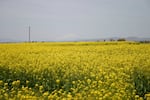The Oregon House voted Thursday to keep a cap on canola farming in the Willamette Valley in place into early 2028. For some legislators and stakeholders looking for a compromise, that means more debate over an already yearslong issue.
Since 2013, the Legislature has kept in place a 500-acre limit on canola farming in the Willamette Valley Protected District, which stretches from Multnomah to Lane County. It was originally set to 500 acres for Oregon State University researchers to study the effects of the crop in the valley.
The limit is because canola, which is mainly grown for its seed to produce cooking oil and livestock feed, is a Brassica crop – part of a large family of plants that includes vegetables like broccoli, cabbage, mustards, radish and kale.
Because they share the same plant family, growing canola near other Brassicas can lead to cross-pollination, and can bring disease and pests. That could damage yields for specialty Brassica seed growers who worry it could alter the purity of their own Brassica seeds.
Groups against expanding canola argue the Willamette Valley is one of few places in the world with the ideal conditions to grow seed for Brassicas.

FILE - Canola grows in an Oregon field in this undated file photo.
Oregon Department of Agriculture
On the other hand, canola supporters, of whom a vast majority are grass seed farmers, say canola is a good crop to add in rotation with their grass seed fields because it improves soil health and combats weeds. It’s also a commodity crop that can supplement a farmer’s income when markets for grass seeds or other crops like wheat or oats aren’t as strong.
A compromise version of HB4059, discussed in the House Committee on Agriculture, Land Use, Natural Resources, and Water, would’ve expanded canola production to 2,500 acres, and then would have lifted all limits after the 2025 harvest season. It also would have permanently limited genetically engineered canola varieties to 500 acres, set an isolation distance between canola and other Brassica crops and directed the Oregon Department of Agriculture to set up a public tracking or “pinning” map to avoid conflicts.
State Rep. Ken Helm, D-Beaverton, chair of the House Agriculture Committee, said groups were close on a compromise, but they couldn’t agree on whether genetically engineered canola should be grown in the valley and how far isolation distances should be.
“Our constituents are not sure, they’re not sure if it’s worth the risk of allowing genetically engineered crops into the Willamette Valley,” Helm said. “That was certainly expressed very clearly by the outright fear of some of the seed growers and organic growers, because they have contracts with international buyers and those buyers want absolutely pure seeds and they can reject contracts just because there’s a hint of genetically modified organisms in the mix.”
Canola supporters point to the 2017 Oregon State University study that found canola and other Brassica plant species could coexist in the valley.
State Rep. Anna Scharf, R-Amity, a member of the House Agriculture Committee — whose family is among a small group of farmers that grow canola in the valley — said continuing the 500-acre cap ignores the science put out through the OSU study. But more significantly, it favors some agricultural groups over others, particularly at a time when grass seed markets aren’t as strong, according to Scharf.
“This may not sound like a big deal, but to these farmers it’s their life,” Scharf said. “They were really hoping that this body could get to a place where they could have a commodity crop to replace those grass seed acres until those markets recovered…it truly was their lifeline.”
Rep. Helm said had the Legislature not voted on a bill to keep the acreage cap, it would’ve left canola farming in the Willamette Valley Protected District unregulated, since the current law keeping the 500-acre rule sunsets this summer.
“Which would mean the [Oregon] Department of Agriculture would not have a way to manage the growing of canola in the valley for whatever is left of the growing season and next,” Helm said. “That would essentially let the genie out of the bottle.”
Helm added that, just because the Legislature voted to continue the acreage cap, it doesn’t mean the Agriculture Committee and legislative body can’t revisit the issue once tensions cool off. The bill passed the House mostly along party lines and it now heads to the Senate.
